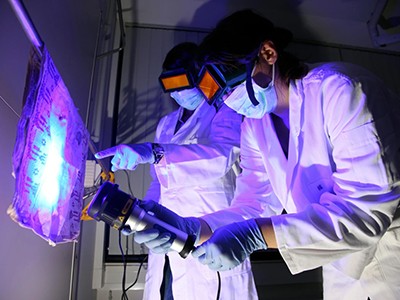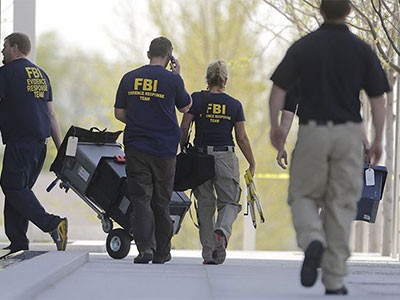
Barbara Rae-Venter helped to identify the Golden State Killer and crack other unsolved cases.
I Know Who You Are: How an Amateur DNA Sleuth Unmasked the Golden State Killer and Changed Crime Fighting Forever Barbara Rae-Venter Ballantine (2023)
In April 2018, California authorities arrested one of the most vicious serial killers in US history. A man known variously as the East Area Rapist, the Original Night Stalker and, eventually, the Golden State Killer committed at least 13 murders, more than 50 rapes and 100 burglaries from the mid-1970s to about 1986. For around 40 years, local and federal investigators sought to identify him. Not once had the actual perpetrator, former police officer Joseph DeAngelo, come under suspicion. In the end, it took about four months of work by a retired patent attorney, Barbara Rae-Venter, to identify the culprit using investigative genetic genealogy (IGG).

The ethics of catching criminals using their family’s DNA
IGG involves pinpointing individuals by constructing detailed family trees using public records and genetic information that people have uploaded to consumer DNA databases, usually to research their own ancestry and family history. The Golden State Killer wasn’t the first cold case to be solved using the technique. It wasn’t even Rae-Venter’s first. Her start in criminal justice came in part through the case of Lisa Jensen, who had been abducted as a child and knew nothing about her past — not even her real name. Rae-Venter and other volunteers from a group that helps people who were adopted find their birth parents turned their skills to identifying Jensen. It took about a year to reveal her true identity, and that information set investigators on a path towards linking Jensen’s abductor, Terry Rasmussen, to a grisly trail of murders.
Word of Rae-Venter’s success spread and caught the attention of Paul Holes, a California detective with dreams of closing the Golden State Killer case before he retired. Unlike Jensen’s, this investigation required sleuths to create a fake profile using crime-scene DNA from an unwitting database participant — the putative killer — without their consent. Most DNA-database companies, including 23andMe and Ancestry, prohibit that. But one, GEDmatch, did not expressly forbid law-enforcement searches in its terms of service. Another, FamilyTreeDNA, agreed to create and upload the Golden State Killer’s profile in secret.
Genealogy in the spotlight
Table of Contents
In I Know Who You Are, Rae-Venter tells of her involvement in identifying Jensen, Rasmussen, DeAngelo and others. Written with bestselling author Alex Tresniowski, it is a gripping story tracing the hundreds of hours spent rifling through people’s family ties to find killers and identify bodies. But the book disappoints when examining the ethical quandaries that Rae-Venter’s actions have sparked.
DeAngelo’s arrest put IGG under a white-hot spotlight. Although genealogists knew that this technique could be used to solve crimes, Rae-Venter was one of the first to break the glass and actually do it. IGG was hailed by some as the biggest scientific advance in crime-fighting since the introduction of DNA evidence. Nature named Rae-Venter one of ten people who mattered in science that year.

The controversial company using DNA to sketch the faces of criminals
But as law-enforcement officials started pushing the boundaries of the tool’s use, there was a backlash. In May 2019, it was revealed that, for another case, investigators had uploaded a DNA sample from a non-sexual assault to GEDmatch. The move violated the site’s updated terms of service, which allowed submissions by law-enforcement agencies only in cases of homicide and sexual assault. That signalled to critics that their fears of a slippery slope were well founded. Confronting user anger, GEDmatch made a U-turn, allowing law-enforcement officers to search the data only of people who had explicitly given their consent. Further consternation was caused in August that year when an investigation by The Wall Street Journal revealed FamilyTreeDNA’s secret agreement with investigators.
Matters of privacy and transparency began to divide the genetic-genealogy field. Law-enforcement officials were scouring personal family details in ways that website users didn’t expect and didn’t necessarily sign up for. As one genealogist put it in a news article for The Atlantic, genetic genealogy “was built for reuniting families, and now it is being used essentially to get families to put their members in jail”.
Rae-Venter scoffs at these concerns, arguing that the horrendous nature of the crimes under investigation is justification enough: “It simply did not strike me as a complicated ethical issue.” She quotes critics of IGG, but she doesn’t deeply explore their arguments about where the line should be drawn in applying the technique. She makes passing reference, for example, to the concerns about using IGG to identify the remains of abandoned infants, ostensibly to find and prosecute the mothers. But she doesn’t fully consider what such prosecutions mean for justice and public safety: research has shown that neonaticide is rarely the act of a violent criminal and more often involves factors such as social isolation and inadequate access to health care.

Supercharged crime-scene DNA analysis sparks privacy concerns
Rae-Venter observes that most cold cases to which IGG is applied involve white people who had been killed or raped, reflecting a preferential bias in law enforcement. But she also notes that the over-representation of white people in consumer DNA databases means that IGG will be most successful at identifying white suspects. She strangely refers to this as a reverse bias, presumably alluding to the systemic racism in US law enforcement that otherwise sees disproportionately high rates of incarceration among Black people. That she takes time to discuss how to address this limitation, but not others, in IGG is troubling.
Her nonchalance on such sensitive matters in dealing with the ethics of IGG mars an otherwise compelling book. IGG is a powerful tool. It has brought closure to more than 1,000 cold cases, by Rae-Venter’s estimates. And as the field grows and consolidates from the domain of hobbyists and volunteers to that of a few well-funded companies, it’s worth not only recounting the details of its ascension — but also analysing more fully its shortcomings and potential for abuse.
Competing Interests
The author declares no competing interests.
